Associations between single and combined exposures to environmental phenols and ulcerative colitis in American adults
IF 2.6
4区 医学
Q2 GASTROENTEROLOGY & HEPATOLOGY
Clinics and research in hepatology and gastroenterology
Pub Date : 2024-09-21
DOI:10.1016/j.clinre.2024.102468
引用次数: 0
Abstract
Objective
The etiology of ulcerative colitis (UC) is complex and involves multiple factors, with exposure to environmental toxins potentially contributing greatly to its pathogenesis. Therefore, this study was carried out with the purpose of delving into the associations between single and combined exposures to environmental phenols and UC among American adults.
Methods
Survey data from the 2009–2010 National Health and Nutrition Examination Survey were selected for our research. The associations between single and combined exposures to environmental phenols and the prevalence of UC were analyzed using weighted multivariate logistic regression models as well as Bayesian kernel machine regression (BKMR).
Results
A total of 1,422 adults aged 20 years old and above were included in this study, 17 of whom had UC. The correlation matrix showed strong associations between 2,4-dichlorophenol (2,4-DCP) and 2,5-dichlorophenol (2,5-DCP) (R = 0.81), as well as between 2,4,5-trichlorophenol (2,4,5-TCP) and 2,4,6-trichlorophenol (2,4,6-TCP) (R = 0.73). The logistic regression model revealed that, after adjusting for confounders, exposure to environmental phenols was positively associated with the prevalence of UC, with 2,4,6-TCP showing a significant association (OR = 2.37, 95 % CI = 1.10, 5.09, P = 0.037). The BKMR analysis indicated an upward trend in the overall effect of combined exposures to environmental phenols on UC. All five phenols contributed to this effect, with 2,4,6-TCP exhibiting the most pronounced effect. When other compounds were fixed at the 50th percentile, the impact of the five phenols on UC demonstrated a positive association, without any noteworthy interaction among the compounds.
Conclusion
Our findings suggested that exposure to environmental phenols may contribute to the occurrence of UC among American adults.
美国成年人单一和综合暴露于环境酚类与溃疡性结肠炎之间的关系。
目的:溃疡性结肠炎(UC)的病因复杂,涉及多种因素,环境毒素的暴露可能在很大程度上导致其发病。因此,我们开展了这项研究,旨在深入研究美国成年人单一和综合暴露于环境酚类与溃疡性结肠炎之间的关系:我们的研究选取了 2009-2010 年全国健康与营养调查的调查数据。我们使用加权多元逻辑回归模型和贝叶斯核机器回归(BKMR)分析了环境酚类的单一暴露和综合暴露与 UC 患病率之间的关系:本研究共纳入了 1 422 名 20 岁及以上的成年人,其中 17 人患有 UC。相关矩阵显示,2,4-二氯苯酚(2,4-DCP)和 2,5-二氯苯酚(2,5-DCP)之间(R = 0.81)以及 2,4,5-三氯苯酚(2,4,5-TCP)和 2,4,6-三氯苯酚(2,4,6-TCP)之间(R = 0.73)存在密切联系。逻辑回归模型显示,在对混杂因素进行调整后,暴露于环境酚类与 UC 患病率呈正相关,其中 2,4,6-TCP 显示出显著的相关性(OR = 2.37,95% CI = 1.10,5.09,P = 0.037)。BKMR 分析表明,环境酚类的综合暴露对 UC 的总体影响呈上升趋势。所有五种酚类都对这一效应有影响,其中 2,4,6-三氯丙醇的影响最为明显。当其他化合物的浓度固定在第 50 百分位数时,五种酚类对 UC 的影响呈正相关,而化合物之间没有任何值得注意的相互作用:我们的研究结果表明,接触环境中的酚类物质可能会导致美国成年人发生多发性硬化症。
本文章由计算机程序翻译,如有差异,请以英文原文为准。
求助全文
约1分钟内获得全文
求助全文
来源期刊

Clinics and research in hepatology and gastroenterology
GASTROENTEROLOGY & HEPATOLOGY-
CiteScore
4.30
自引率
3.70%
发文量
198
审稿时长
42 days
期刊介绍:
Clinics and Research in Hepatology and Gastroenterology publishes high-quality original research papers in the field of hepatology and gastroenterology. The editors put the accent on rapid communication of new research and clinical developments and so called "hot topic" issues. Following a clear Editorial line, besides original articles and case reports, each issue features editorials, commentaries and reviews. The journal encourages research and discussion between all those involved in the specialty on an international level. All articles are peer reviewed by international experts, the articles in press are online and indexed in the international databases (Current Contents, Pubmed, Scopus, Science Direct).
Clinics and Research in Hepatology and Gastroenterology is a subscription journal (with optional open access), which allows you to publish your research without any cost to you (unless you proactively chose the open access option). Your article will be available to all researchers around the globe whose institution has a subscription to the journal.
 求助内容:
求助内容: 应助结果提醒方式:
应助结果提醒方式:


